pressure die casting
Pressure Die Casting A Key Manufacturing Process
Pressure die casting is a manufacturing process that plays a crucial role in producing high-quality metal components with excellent dimensional accuracy and surface finish. This technique is particularly effective for creating complex shapes and designs, making it ideal for various industries, including automotive, aerospace, electronics, and consumer products. Understanding the fundamentals of pressure die casting can provide insight into its benefits, applications, and the overall manufacturing process.
The Process of Pressure Die Casting
The pressure die casting process involves forcing molten metal into a mold under high pressure. This method is typically used for non-ferrous metals, such as aluminum, zinc, and magnesium alloys. The process can be broken down into several key steps
1. Mold Preparation In pressure die casting, molds are usually made from high-strength steel to withstand repeated use and the intense pressure of the molten metal. The mold design is critical, as it dictates the shape and features of the final product. Often, these molds come with complex geometries to ensure that intricate designs can be replicated accurately.
2. Melting the Metal The chosen metal alloy is heated in a furnace until it reaches a liquid state. The temperature and consistency of the molten metal must be carefully controlled to ensure optimal flow characteristics during the casting process.
3. Injection of Molten Metal Once the metal is molten, it is injected into the mold at high speed and pressure, typically ranging from 1,000 to 2,500 psi. This high-pressure injection helps eliminate air pockets and ensures that the metal fills every cavity in the mold, resulting in a dense and robust final product.
4. Cooling and Solidification After the molten metal has filled the mold, it is allowed to cool and solidify. Cooling time can vary depending on the complexity of the part and the material used. Efficient cooling is essential to ensure that the product maintains its shape and is free from defects.
5. Ejection and Finishing Once the casting has cooled sufficiently, the mold is opened, and the finished part is ejected. This process may be followed by various finishing operations, such as machining, surface treatment, or polishing, to meet specific customer requirements.
pressure die casting

Advantages of Pressure Die Casting
Pressure die casting offers several advantages, making it a preferred choice for many manufacturers
1. High Precision and Detail The exceptional accuracy of the molds allows for the production of intricate designs with tight tolerances, reducing the need for extensive post-processing.
2. Cost-Effective for Mass Production Although the initial cost of creating a die can be high, the cost per unit drops significantly as production volumes increase. This makes pressure die casting a cost-effective method for large-scale manufacturing.
3. Excellent Surface Finish Parts produced through pressure die casting have a smooth surface finish that often requires little to no additional machining.
4. Material Efficiency The process minimizes waste since most of the metal can be reused in subsequent melts, thereby reducing material costs and environmental impact.
5. Versatility A wide range of alloys can be used, providing manufacturers with flexibility in material selection based on the desired properties of the final product.
Conclusion
In summary, pressure die casting is an essential manufacturing process that combines efficiency with precision to produce high-quality metal components. As industries continue to seek innovative solutions to meet their production needs, understanding and utilizing advanced techniques like pressure die casting will remain vital in driving economic growth and technological development. Whether it's automotive parts or electronic casings, the contributions of this technique are undeniably impactful across multiple sectors.
-
Precision Sheet Metal Stamping Manufacturer | Fast & ReliableNewsAug.01,2025
-
OEM Sand Cast Pump Valve Fittings - Baoding Hairun Machinery And Equipment Trading Co., Ltd.NewsAug.01,2025
-
Custom OEM Impellers | High Efficiency & PrecisionNewsAug.01,2025
-
OEM Sand Cast Pump Valve Fittings - Baoding Hairun Machinery | Customization, Quality AssuranceNewsAug.01,2025
-
OEM Sand Cast Pump Valve Fittings - Baoding Hairun Machinery And Equipment Trading Co., Ltd.NewsAug.01,2025
-
OEM Sand Cast Pump Valve Fittings - Baoding Hairun Machinery And Equipment Trading Co., Ltd.NewsJul.31,2025















